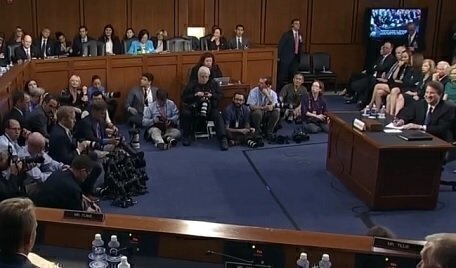On Friday, the Senate Judiciary Committee is scheduled to end its public hearings about Brett Kavanaugh’s confirmation to the Supreme Court. So what comes next in the process?
 After the hearings conclude, the committee will then vote to make a recommendation to the Senate about Kavanaugh’s confirmation to replace Anthony Kennedy on the bench. Usually, the Judiciary Committee reconvenes within a week to make a recommendation that is favorable, negative, or not a recommendation at all. Committee chair Chuck Grassley will make the decision about when that public session happens.
After the hearings conclude, the committee will then vote to make a recommendation to the Senate about Kavanaugh’s confirmation to replace Anthony Kennedy on the bench. Usually, the Judiciary Committee reconvenes within a week to make a recommendation that is favorable, negative, or not a recommendation at all. Committee chair Chuck Grassley will make the decision about when that public session happens.
Either way, the matter then proceeds to the full Senate for debate and a vote, with the committee’s action reported for consideration.
Of the 15 nominations since 1975 reported by the Judiciary Committee to the full Senate, 13 of the nominations were favorable. The exceptions were Robert Bork in 1987 (who was reported unfavorably) and Clarence Thomas in 1991 (who was reported without recommendation). Stephen Breyer and Ruth Bader Ginsburg were the last two nominees to get unanimous favorable recommendations from the Judiciary Committee.
Traditionally, the Judiciary Committee had compiled a full written report for the Senate to consider, but in recent nominations, the Committee chair has sent a one-page report to the Senate confirming the committee’s recommendation. Due to the public nature and reporting of the hearings, the Senate will be informed about the events that transpired.
Committee chair Chuck Grassley will send the recommendation to Senate Majority Leader Mitch McConnell, who will schedule an executive session to consider the confirmation vote. On average since 1975, the Congressional Research Services says that it has taken eight days for the Senate to confirm a Supreme Court candidate once it has received a report or notice from the Senate Judiciary Committee chairman.
Through various parliamentary procedures, McConnell will get the confirmation vote to the full Senate to consider on the floor. One option not in play is a filibuster by the Democrats. The Senate eliminated that option during Neil Gorsuch’s confirmation in April 2017.
The time for floor debate is usually divided equally between the Democrats and the Republicans. The time is limited under the April 6, 2017 filibuster decision allowing a Senate majority (and not 60 Senators under a prior rule) to invoke cloture, or a fixed time period for debate. A cloture motion receives a vote after two days of Senate sessions, and if passed, limits debate to a maximum of 30 additional hours.
In Gorsuch’s case, the cloture motion was filed on April 4, 2017, the motion was considered and McConnell’s ruling change was made on April 6, 2017. Gorsuch’s confirmation vote was the next day.
Once the floor debate concludes, the Senate’s presiding officer, in this case, Vice President Mike Pence, will submit the following question to the floor: “The question is, Will the Senate advise and consent to the nomination of Brett Kavanaugh of Maryland to be an Associate Justice on the Supreme Court?”
The “advice and consent language” is consistent with the Treaty and Appointments Clauses in Article II, Section 2, of the Constitution.
A roll call vote is taken, and a simple majority is needed to confirm. In the event of a tie vote, the Vice President can vote to break the tie. But according to Senate records, that has never happened in a Supreme Court confirmation vote.
When a nominee is confirmed, the Secretary of State is notified of the Senate’s actions and a confirmation letter is sent to the White House. The President signs a document called a commission, which is sent to the new Justice. Then, the confirmed Justice takes part in two swearing-in ceremonies. In one instance, the Justice take a judicial oath; the other ceremony involves a constitutional oath. A current Supreme Court Justice administers both oaths, and the constitutional oath is administered at a public ceremony attended by the President. In 2017, Chief Justice John Roberts gave the oath to Gorsuch in the private ceremony, while Associate Justice Anthony Kennedy did likewise at the public ceremony.
Scott Bomboy is editor in chief of the National Constitution Center.







